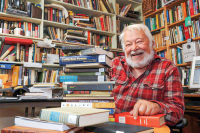The essential nature of winter
When late November finally arrives, my wife, Elizabeth, and I go into another mode. Her busy season in the gallery-studio she operates here on the town square in Bryson City pretty much comes to an end. The Elderhostel programs, workshops and lectures that keep me on the road from mid-March into November come to an abrupt halt. From now until early spring we get to spend more time together at our home place in a little cove four miles west of town. Winter is our time of the year.
Wouldn’t you hate to live in an area where there was no true winter or in an area where winter lasted too long? The southwestern region of Western North Carolina is, in our opinion, the ideal place to live in this regard. Once you get up around Boone or into the Blacksburg region of Virginia, winters become serious affairs. Here the winters are just right.
Winter is the season of light. Following summer’s haze and the soft tones of autumn, we’re not always confronted with the gloom we tend to anticipate but with a shimmering brightness that makes windowpanes gleam.
After a snowfall the wonder of winter light reaches its peak. Snow sparkles on the mountains and fields. Rock walls and the foundations of old homesteads normally overlooked are redefined, once again becoming a part of our daily lives.
But even without snow, winter light maintains its peculiar quality. It is so pure we see the edges of things more clearly. Twigs and branches are crosshatched against the sky with lines as fine as the pen strokes in an artist’s line drawing. In this light our world becomes more distinct, more exhilarating.
Related Items
Winter is also the evergreen time of the year. When we walk along the trail that leads down from our cabin alongside the creek, we can’t avoid seeing the obvious evergreens like American holly, rhododendron, mountain laurel, doghobble, greenbrier, Christmas fern, clubmoss (ground cedar), galax, and the like.
What we especially watch for are the less obvious evergreens that brighten the leaf-litter on a slushy winter day: puttyroot and cranefly orchis (orchid species that display their leaves only in winter); pipsissewa and wintergreen (two upright, partially woody plants that are sometimes described as “sub-shrubs” because of their diminutive stature); rattlesnake plantain; and trailing arbutus and partridgeberry (two prostrate plants that are sometimes described as “creepers” because they don’t climb like true vines).
One of our favorites is partridgeberry, which has several other common names, including squawvine, twin-berry, two-eyed berry, Mitchella vine, and nerve vine, all descriptive of the plant’s botanical characteristics or human uses.
The generic designation honors the 18th century Virginia physician and botanist John Mitchell (who corresponded with Carolus Linnaeus, that great namer of plants), while the species tag “repens” notes its “creeping” habit.
Indeed, the vine can spread over fairly large areas, carpeting roots, small rock outcrops, and fallen tree trunks. In winter the paired dark-green oval leaves with their yellowish-green vein patterns make a pleasant sight.
In May and June attractive four-lobed, lilac-scented white flowers appear whose interiors are clothed with velvety white hairs. Close observation reveals that the flowers appear in pairs with fused bases. The fused ovaries produce a double berry; that is, one berry composed of two parts. In winter, you can easily spot two indentations on the end of each coral red berry that indicate where the paired sepals were located.
Winter scales life down to bare essentials. Textures and singularities stand out. It is the time for truly seeing things as they are, for paying close attention to the world about us while we can.
George Ellison wrote the biographical introductions for the reissues of two Appalachian classics: Horace Kephart’s Our Southern Highlanders and James Mooney’s History, Myths, and Sacred Formulas of the Cherokees. In June 2005, a selection of his Back Then columns was published by The History Press in Charleston as Mountain Passages: Natural and Cultural History of Western North Carolina and the Great Smoky Mountains. Readers can contact him at P.O. Box 1262, Bryson City, N.C., 28713, or at This email address is being protected from spambots. You need JavaScript enabled to view it..
Answers to last week's quiz:
(1) b; (2) a; (3) b; (4) a; (5) c; (6) c; (7) a; (8) b; (9) a; (10) b; (11) a; (12) c; (13) c; (14) c; (15) c; (16) a; (17) b; (18) c; (19) b; and (20) a.









